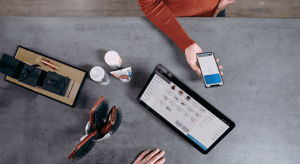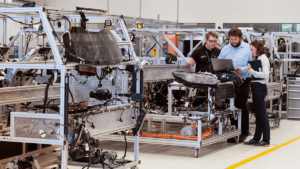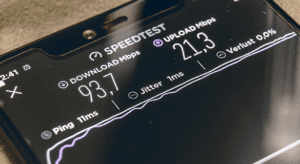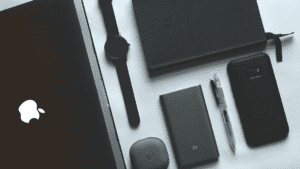Resources
Trends in IoT and Mobile Apps

By May 2023, the number of global IoT connections had increased by 18% to 14.3 billion endpoints – that’s a lot of connected devices, and a lot of room for innovation. Furthermore, we’re looking at the likelihood that by 2027, it’s possible that the amount of connected devices will nearly double, adding thousands of new possibilities into the industry.
Most importantly, IoT has a favourable reputation within the market, and it seems to have avoided the same kind of negative impact that other tech companies have generated through layoffs and other uncertainties. That sets the stage for some pretty interesting trends, and opens up a lot of opportunities for intersection with other industries, such as mobile apps.
Let’s talk about what IoT actually is first.
What is IoT?
IoT is the internet of things: devices that use sensors and software to connect with, and send information to, other devices over the internet. This is stuff like your smart bulbs turning on via an app on your phone, or being able to remotely monitor how much water usage your sprinkler system uses. It can be used for basically any device that can be reprogrammed with a sensor, and it’s growing in popularity as a way of working smarter, and better, with what you have.
Here’s some trends we can already see coming into play.
Consolidation of existing platforms.
The playing field for IoT platforms has kind of levelled out a little now: initially, the push towards IoT and the forward jump into innovation prompted a lot of companies to launch their own IoT platform. Think of IBM’s original version of its Watson IoT platform, or Google’s IoT Core, however by that point Amazon’s AWS and Microsoft Azure IoT already had a sizeable portion of the market, and profit was kind of low in spite of the interest in IoT devices.
What’s happening now is that those shuttered IoT platforms are being turned into partnerships or solutions specific for IoT. For example, Google has partnered up with industry data company Litmus Automation to deliver faster results and combine edge computing with their cloud services for a fuller picture of machine data.

AI Support
AI is every industry’s new reckoning, and the IoT industry is no different. There are already companies working to create ways in which data from IoT devices can be analyzed through AI and machine learning, and to use that same data for training. However, this trend will likely take a little longer to come to fruition, given how quickly the AI industry is changing day by day.

Industrial IoT
IoT in factories is nothing new, but the ongoing skilled worker shortages affecting the industry globally has resulted in a big push to supplement human labourers with robotics and automation. This has massive potential to overwrite the way that factories are built and function, with IoT services working to create safer, more efficient factories that free up time for human workers to pursue other things that require a different set of skills.

Replacement with 4G/5G networks
4G and 5G connections have been in the works for a while, and what this means is this: more connections, faster, and in harder-to-reach areas. Think of your grandmother who lives out in the boondocks, just out of reach of normal 2G and 3G services.
This is another trend that’s been slowly in the works, but it’s becoming a bigger investment by the day – as 2G and 3G networks are replaced with the next generation of connectivity, the scope of IoT connections will increase significantly, both for urban networks and some of the more easily connected rural environments. This could potentially push the adoption of IoT devices further, though it will all depend on how network connectivity spread plays out – but we’re hopeful it’s going to lead to a more connected world.

What does IoT have to do with mobile apps?
Mobile apps and IoT go hand in hand, especially with the rate at which the IoT industry is slowly increasing its impact in business and industrial environments.
For one thing: IoT and mobile apps are great for business intelligence. As companies turn to IoT as a way to further their efficiency, all that data and all that digitization has to be analyzed somewhere, and there’s no better environment to understand and monitor the changes to your business than using an app. An app created in conjunction with IoT means that you are updated to the minute on how your business is doing, and rather than focusing on a single area of analysis, IoT can provide you a top-down view of the way your organization works.
It’s a little more complicated than that, but with the reduction in IoT platforms and the new partnerships that we’re likely going to see as a result of companies trying to compete with the ones that have the biggest market share, it’s become a lot easier for businesses of any size and scale to invest in IoT and use a mobile app to monitor that business.
Here’s a few from the top of our heads.

Manufacturing:
Manufacturing is going to be one of the biggest sectors for IoT innovation for 2023 and beyond, and it’s easy to understand why: factories are massive, sprawling complexes with a lot of sophisticated machinery, high turnaround, and deadlines to meet that absolutely can’t be budged, and with the shortages of raw materials, any small glitch in operations can be devastating for a business.
However, if you use IoT to monitor the way your factory is working, then it’s easier to notice when it isn’t – and programming your smart sensors to send data directly to a mobile app can lead to solutions at a much quicker pace. After all, if all your data is being fed into an app that sends information directly to the operator, any variation in output is going to be a lot easier to spot than if you had to do so manually.
Telemedicine:
Telemedicine and virtual medicine took a boost during COVID-19, when going to the doctor’s office wasn’t safe and people were looking for alternative ways to communicate with their medical practitioners, and as it turns out, it works really well if the technology works with you. With IoT, you can connect patients’ wearable devices to an app that is then viewable by your medical practitioner – and it beats having to describe your symptoms yourself, since your doctor will have the hard data from your wearable devices. This can be taken a step further and integrated with AI to provide diagnosis for minor issues.
Retail:
Monitoring inventory is one thing, but you can also push smart sensors to give you information on the overall shopping experience. These can help analyze customer data, and on the client side, you can also implement AI learning to make recommendations based on customers’ previous shopping experiences.
What does this mean for me?
If you’re a company that’s looking into breaking into IoT devices, or a company that can benefit from IoT devices, it might also be worth thinking about designing a mobile app that can analyze and understand that data for you and deliver it to whichever operator needs the information. Mobile apps and IoT devices can work to streamline your business significantly, and if you need a little more information on how, you should contact us – we’re always happy to help explain how this can benefit you and your business.